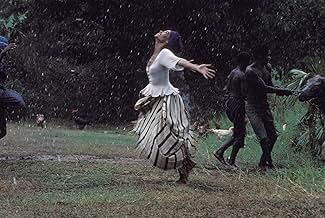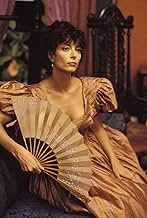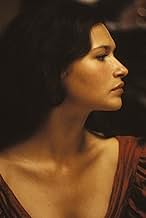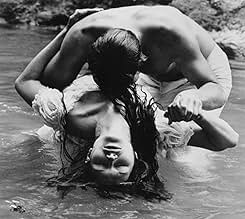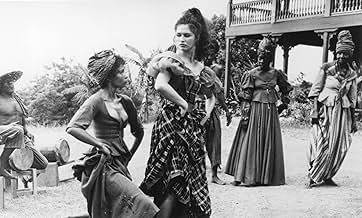CALIFICACIÓN DE IMDb
5.6/10
2.3 k
TU CALIFICACIÓN
En la Jamaica de 1840, una joven terrateniente se casa con un inglés para quedarse con su propiedad. Su amor florece, pero ella esconde un secreto de la infancia sobre su madre que amenaza s... Leer todoEn la Jamaica de 1840, una joven terrateniente se casa con un inglés para quedarse con su propiedad. Su amor florece, pero ella esconde un secreto de la infancia sobre su madre que amenaza su relación.En la Jamaica de 1840, una joven terrateniente se casa con un inglés para quedarse con su propiedad. Su amor florece, pero ella esconde un secreto de la infancia sobre su madre que amenaza su relación.
- Dirección
- Guionistas
- Elenco
Martine Beswick
- Aunt Cora
- (as Martine Beswicke)
Opiniones destacadas
A young woman (Karina Lombard) marries an Englishman (Nathaniel Parker) in mid-1800s' Jamaica to save her plantation. Rachel Ward plays her mother, Michael York her stepfather and Martine Beswick her aunt, all three being small roles.
"Wide Sargasso Sea" (1993) is an adult-oriented historical drama that's a quasi-prequel to "Jane Eyre." I say "quasi" because the 1966 novel the movie was based on was written by Jean Rhys 119 years after the release of Charlotte Bronte's "Jane Eyre" in 1847. In other words, "Wide Sargasso Sea" is Rhys' proposed prequel of that famous story, not the official one.
The movie works better if you are familiar with "Jane Eyre," but it's not absolutely necessary. Naturally, "Wide Sargasso Sea" gives you a better understanding of what's happening in "Jane Eyre," which has been made into several movies, e.g. the 1970 version with George C. Scott & Susannah York, which is the only version I've seen.
The best thing about this movie is the setting, cast and style. It successfully takes you back in time to Jamaica circa early 1850s. The two protagonists are thoroughly convincing, as are Claudia Robinson as Antoinette's nurse, an obeah (voodoo) witch, and Rowena King as Amelie, an island girl who thinks she's hotter than she is. Really, the whole cast rises to the challenge.
There's a revolt by ex-slaves in the first act that's both realistic and harrowing. The story gets brighter with Antoinette & Edward's honeymoon, but takes a dark turn in the second half. I didn't feel there was enough cause to justify Edward's metamorphosis. The filmmakers' should've made this clearer. There's a measure of ugliness with the last half being downbeat. If you can handle that, it's worth checking out. It basically mixes Brando's "Burn!" (1969) with "The Piano" (1993) and "Sirens" (1994), the latter two debuting within a year after this one.
The film runs 1 hour and 38 minutes and was shot in Jamaica with a small bit in England.
GRADE: B-
"Wide Sargasso Sea" (1993) is an adult-oriented historical drama that's a quasi-prequel to "Jane Eyre." I say "quasi" because the 1966 novel the movie was based on was written by Jean Rhys 119 years after the release of Charlotte Bronte's "Jane Eyre" in 1847. In other words, "Wide Sargasso Sea" is Rhys' proposed prequel of that famous story, not the official one.
The movie works better if you are familiar with "Jane Eyre," but it's not absolutely necessary. Naturally, "Wide Sargasso Sea" gives you a better understanding of what's happening in "Jane Eyre," which has been made into several movies, e.g. the 1970 version with George C. Scott & Susannah York, which is the only version I've seen.
The best thing about this movie is the setting, cast and style. It successfully takes you back in time to Jamaica circa early 1850s. The two protagonists are thoroughly convincing, as are Claudia Robinson as Antoinette's nurse, an obeah (voodoo) witch, and Rowena King as Amelie, an island girl who thinks she's hotter than she is. Really, the whole cast rises to the challenge.
There's a revolt by ex-slaves in the first act that's both realistic and harrowing. The story gets brighter with Antoinette & Edward's honeymoon, but takes a dark turn in the second half. I didn't feel there was enough cause to justify Edward's metamorphosis. The filmmakers' should've made this clearer. There's a measure of ugliness with the last half being downbeat. If you can handle that, it's worth checking out. It basically mixes Brando's "Burn!" (1969) with "The Piano" (1993) and "Sirens" (1994), the latter two debuting within a year after this one.
The film runs 1 hour and 38 minutes and was shot in Jamaica with a small bit in England.
GRADE: B-
Anyone who has ever read Jane Eyre, Charlotte Bronte's brooding masterpiece, knows the adult, world-weary Edward Rochester. They also know about the secret locked in the tower room of Thornfield Hall. What Charlotte never fully explains is how Mr. Rochester came to be the aloof, stony man he is and how is wife came to be mad.
Well, The Wide Sargasso Sea attempts to answer those questions. In my opinion The Wide Sargasso Sea does an excellent job.
This is a vivid and sensual film, and depending on the version you see, VERY explicit. But in this case I think the nudity and sexual activity is justified and not gratuitous.
Nathaniel Parker gives a stunning performance as Rochester. I recommend this one.
I like to watch The Wide Sargasso Sea first and then put on my VHS of the splendid A&E production of Jane Eyre with Ciarn Hinds as Rochester. The two follow each other beautifully and seen together, the puzzle of Edward Rochester is solved, at least to my satisfaction.
Well, The Wide Sargasso Sea attempts to answer those questions. In my opinion The Wide Sargasso Sea does an excellent job.
This is a vivid and sensual film, and depending on the version you see, VERY explicit. But in this case I think the nudity and sexual activity is justified and not gratuitous.
Nathaniel Parker gives a stunning performance as Rochester. I recommend this one.
I like to watch The Wide Sargasso Sea first and then put on my VHS of the splendid A&E production of Jane Eyre with Ciarn Hinds as Rochester. The two follow each other beautifully and seen together, the puzzle of Edward Rochester is solved, at least to my satisfaction.
The Wide Sargasso Sea is one of the most beautiful books ever written. Following a string of only mildly successful novels and short stories, Rhys disappeared off the radar, and many believed her dead. She was discovered years later living in seclusion on the south of England. Throughout her house were numerous manuscripts forming what became The Wide Sargasso Sea. The novel was a labour of love for Rhys in a sense, but despite the critical acclaim it received she described the success as (I paraphrase) too little too late.
Rhys' novel details the relationship between the Rochester of Jane Eyre and Antoinette, his first wife. The novel, however, is not truly about this. The true importance of the story is the oppression of Antoinette by her husband and society as a whole. She is a Creole: inherently hot blooded and passionate. Rochester cannot handle this aspect of her nature, and attempts to remove it from her but cannot; it is inherent.
The film suggests that Anotinette descends into madness. This is not what Rhys wished to demonstrate. Antoinette never went insane, but rather the anger if her treatment at the hands of Rochester drove her to an act of rashness, but not madness. In her actions at the end of the film, Antoinette is not losing control, but rather regaining it.
This is lost in the film. The beautiful story is diminished considerably. The first two sections of the novel are reduced to 10 minutes, making the whole plot seem rushed. This was, it would appear, to make was for as much gratuitous nudity as possible.
All that redeems the film (and the only reason I rated it a 3 and not a 1) is the beautiful depiction of the scenery. I suggest people who have read the book avoid the film, and those interested in both stick to the novel and stay well away from this.
Rhys' novel details the relationship between the Rochester of Jane Eyre and Antoinette, his first wife. The novel, however, is not truly about this. The true importance of the story is the oppression of Antoinette by her husband and society as a whole. She is a Creole: inherently hot blooded and passionate. Rochester cannot handle this aspect of her nature, and attempts to remove it from her but cannot; it is inherent.
The film suggests that Anotinette descends into madness. This is not what Rhys wished to demonstrate. Antoinette never went insane, but rather the anger if her treatment at the hands of Rochester drove her to an act of rashness, but not madness. In her actions at the end of the film, Antoinette is not losing control, but rather regaining it.
This is lost in the film. The beautiful story is diminished considerably. The first two sections of the novel are reduced to 10 minutes, making the whole plot seem rushed. This was, it would appear, to make was for as much gratuitous nudity as possible.
All that redeems the film (and the only reason I rated it a 3 and not a 1) is the beautiful depiction of the scenery. I suggest people who have read the book avoid the film, and those interested in both stick to the novel and stay well away from this.
The following review is taken from my contribution to a thread called "Worst novel adaptations" from the Film General board: Wide Sargasso Sea was originally a beautiful, haunting novel set in mid-19th century Jamaica written by Creole-Welsh writer Jean Rhys in the 1960s. Plot-wise, it's basically the prequel to Charlotte Bronte's Jane Eyre, the story of a young Mr Rochester traveling to the Caribbean and meeting his first wife, the "mad wife" in the attic featured in Jane Eyre (though here she is young and not yet "mad", and we are described what gradually led her to losing her sanity). It's a sensual novel, mainly because the lush Jamaican countryside and emotional spontaneity of the local people was too much for the straight-laced, English Victorian gent, Rochester. But there are no sex scenes in the novel - basically, it's NOT an erotic novel as the film "adaptation" would suggest. It's written in subtle, understated yet powerfully-evoked prose that speaks of the movements of the soul rather than those of the pelvis. There's lots of passion in Wide Sargasso Sea THE BOOK, but it's mostly emotional. It's an extremely multi-layered novel and the work of a true master. The film on the other hand is just your classic, bad 1990s film, beautiful to look at, with lots of skin, languid copulation, heaving bosoms, bodice-ripping nonsense, etc and next to no substance. It has no artistic integrity whatsoever, as its shameless makers must surely know they lifted their middle finger at the spirit of the Jean Rhys novel when choosing to make the film the way they did. None of the understanding of the deepest secrets of the soul that the novel can so miraculously evoke. None of the beauty, poetry, deep, heart-felt tragedy, pathos, haunting quality. Nothing. Just a lot of pointless, choreographed sex between beautiful people in an "exotic" setting. Why not make an erotic version of Jane Eyre while we're at it? Plus there's nothing worse than eroticism that takes itself too seriously. I'd highly recommend the novel by the way: a book you don't forget in a hurry. Needless to say I think you should give this insulting (to the memory of Jean Rhys) film a miss, especially if you've read the novel: it'll just frustrate you, no matter how keen on a bit of easy titillation you may be feeling at the time.
I think that there seem to be some confusion expressed in a number of the reviews of this and a subsequent version of Jean Rhys' most famous novel. Just for information:
1. Creole does not necessarily imply mixed race. Bertha (to use Rochester's name for her) was clearly white enough to appear white and indeed, like Jean Rhys herself, may have been entirely of European ancestry. The mixed race brother, Daniel, was black on his mother's side which has nothing to do with Bertha's mother being mostly/entirely French. He was angry and destructive because his father preferred the white daughter to him.
2. The Wide Sargosso Sea is a sort of prequel but it is also a re-imagining of the back story for Jane Eyre that is intended to take Bertha's character and expand on it with Rhys inability to ever fully reconcile herself to the differences between her origins and life in Europe.
3. While we think of the Caribbean as a dominantly black environment, the origins were Carib Indian and whites colonized the area before the introduction of African slaves. The racial undertone is a more modern view than Bronte likely had. She was trying to deal with the whole idea of foreignness/strangeness and the ultimate solution to the plight of Jane's situation, poor but of "gentle" birth.
4. Of the two filmed versions, the first makes the characters too physically attractive and really misses the novel's stress on the protagonists never meshing rather than loving and losing love.
5. One problem with the casting of Rochester in the first version is that the actor portraying Rochester is distractingly gorgeous and not sufficiently British (apart from his accent). In fact he looks like he rather fits in, in contrast to Bertha's uncle and the other European planters. Of course, the actress who portrays Bertha, even at the end, is so enticing that Rochester's loss of interest is inexplicable.
6. The first film seems to run out of time and rushes the end. Not enough is made of Rochester's anger at being manipulated, whether by voodoo, drugs or circumstances. Once he becomes his father's heir, the return to England should have led to something other than the conclusion. There is definitely insufficient deterioration in Bertha. Their stories are mirror images. He deteriorates and is miserable where she is able to live and she deteriorates where he is able to live.
7. The novels (both Jane Eyre and The Wide Sargosso Sea) have a great deal of narration which is lost in the earlier film and perhaps insufficient in the second. None of the films are substitutes for the books but all are interesting reimaginings.
8. In order to appreciate the Rhys novel, one should read about the author. The same is true of Jane Eyre and its author. The more things change, the more they stay the same.
Finally, while not great, the films both aspire to be literary, which means a lot in an age when filmmakers think there is a need for horror/splatter movies and lots of people apparently agree so I for one say thank you for both versions of the Wide Sargosso Sea and all of the versions of Jane Eyre that offer relief from the current tripe.
1. Creole does not necessarily imply mixed race. Bertha (to use Rochester's name for her) was clearly white enough to appear white and indeed, like Jean Rhys herself, may have been entirely of European ancestry. The mixed race brother, Daniel, was black on his mother's side which has nothing to do with Bertha's mother being mostly/entirely French. He was angry and destructive because his father preferred the white daughter to him.
2. The Wide Sargosso Sea is a sort of prequel but it is also a re-imagining of the back story for Jane Eyre that is intended to take Bertha's character and expand on it with Rhys inability to ever fully reconcile herself to the differences between her origins and life in Europe.
3. While we think of the Caribbean as a dominantly black environment, the origins were Carib Indian and whites colonized the area before the introduction of African slaves. The racial undertone is a more modern view than Bronte likely had. She was trying to deal with the whole idea of foreignness/strangeness and the ultimate solution to the plight of Jane's situation, poor but of "gentle" birth.
4. Of the two filmed versions, the first makes the characters too physically attractive and really misses the novel's stress on the protagonists never meshing rather than loving and losing love.
5. One problem with the casting of Rochester in the first version is that the actor portraying Rochester is distractingly gorgeous and not sufficiently British (apart from his accent). In fact he looks like he rather fits in, in contrast to Bertha's uncle and the other European planters. Of course, the actress who portrays Bertha, even at the end, is so enticing that Rochester's loss of interest is inexplicable.
6. The first film seems to run out of time and rushes the end. Not enough is made of Rochester's anger at being manipulated, whether by voodoo, drugs or circumstances. Once he becomes his father's heir, the return to England should have led to something other than the conclusion. There is definitely insufficient deterioration in Bertha. Their stories are mirror images. He deteriorates and is miserable where she is able to live and she deteriorates where he is able to live.
7. The novels (both Jane Eyre and The Wide Sargosso Sea) have a great deal of narration which is lost in the earlier film and perhaps insufficient in the second. None of the films are substitutes for the books but all are interesting reimaginings.
8. In order to appreciate the Rhys novel, one should read about the author. The same is true of Jane Eyre and its author. The more things change, the more they stay the same.
Finally, while not great, the films both aspire to be literary, which means a lot in an age when filmmakers think there is a need for horror/splatter movies and lots of people apparently agree so I for one say thank you for both versions of the Wide Sargosso Sea and all of the versions of Jane Eyre that offer relief from the current tripe.
¿Sabías que…?
- TriviaThe picture was classified and rated with a restricted NC-17 rating in the USA due to its explicit sexual content. Distributor Fine Line Features decided not to appeal the decision in order to try and gain a lower classification rating to make the movie marketable and able for younger audiences to attend. The New York Times reported "Fine Line Features, the art-film division of New Line Cinema, has accepted the rating for 'Wide Sargasso Sea (1993)' which includes male frontal nudity".
- Citas
Edward Rochester: England seems far away.
- Versiones alternativasEdited, R-rated version available on video.
Selecciones populares
Inicia sesión para calificar y agrega a la lista de videos para obtener recomendaciones personalizadas
- How long is Wide Sargasso Sea?Con tecnología de Alexa
Detalles
Taquilla
- Presupuesto
- USD 4,500,000 (estimado)
- Total en EE. UU. y Canadá
- USD 1,614,784
- Fin de semana de estreno en EE. UU. y Canadá
- USD 33,806
- 18 abr 1993
- Total a nivel mundial
- USD 1,614,784
- Tiempo de ejecución1 hora 39 minutos
- Color
- Relación de aspecto
- 1.85 : 1
Contribuir a esta página
Sugiere una edición o agrega el contenido que falta


